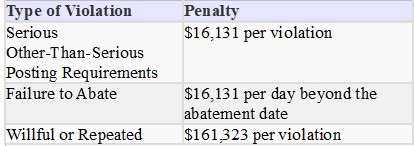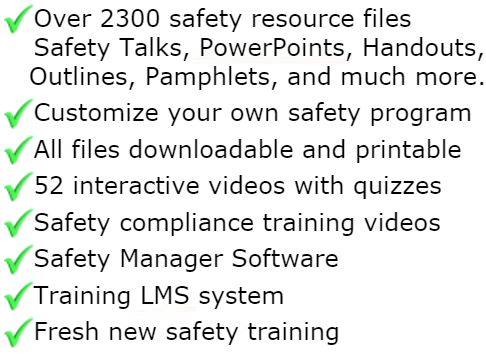
Ergonomics & Material Handling Program
Ergonomics is the scientific discipline concerned with designing according to human needs, and the profession that applies theory, principles, data and methods to design in order to optimize human well-being and overall system performance.
The field is also called human engineering, and human factors. Ergonomic research is performed by those who study human capabilities in relationship to their work demands. Information derived from these studies contributes to the design and evaluation of tasks, jobs, products, environments, ergonomic risk factor analysis and systems in order to make them compatible with the needs, abilities and limitations of people.
Basics of Ergonomics
Ergonomics is the scientific discipline concerned with the understanding of the interactions among humans and other elements of a system . . . that applies theory principles, data and methods to design in order to optimize human well-being . . . ergonomists contribute to design and evaluation of tasks, jobs, products, environments and systems in order to make them compatible with the needs, abilities, and limitations of people."— International Ergonomics Association
Ergonomics means fitting the workplace to the worker by modifying or redesigning the job, workstation, tool, or environment. Ergonomics draws from the fields of engineering, and medical and health sciences to optimize the work environment. By identifying ergonomic hazards that can result in an injury or illness, and correcting these hazards, employees can be provided a healthier workplace. Some of the factors evaluated in an ergonomic analysis are:
• Repetitiveness of a task
• Posture and movement of the limbs and whole body as a task is performed
• Physical strength required for a task
• Design and use of tools
• Design and layout of the work area or equipment
While the primary goal of ergonomics is to minimize employee exposure to ergonomic hazards that lead to Cumulative Trauma Disorders (CTDs) and related injuries and illnesses, the benefits of ergonomics are:
• Improved safety and health in the workplace
• Improved employee morale and job satisfaction
• Improved productivity
• Improved quality of work
• Improved competitiveness in the marketplace
• Reduced probability of accidents and errors
• Reduced absenteeism and employee turnover
• Reduced medical and workers' compensation costs associated with cumulative trauma disorders.
Ergonomics is an ongoing process, not just a quick fix. Continued awareness and cooperation among responsible groups is essential to an effective ergonomics program.
This area of the Safety Library offers a combination of resources and tools to help maximize your comfort and safety. Ergonomics is a combination of good habits, work practices and optimizing the environment. There is no magic bullet and every person and situation possesses unique challenges for making all the pieces fit together.
Cumulative Trauma Disorders
Cumulative trauma disorder (CTD) is not a diagnosis, but a group of health problems with similar characteristics. CTDs are soft tissue disorders (e.g., muscles, tendons, joints, nerves) caused by wear and tear from repetitive motion. CTDs usually occur in the upper body in the neck, shoulders, back, arms, wrists, and hands. It is important to prevent CTDs because they can lead to serious and/or permanent injuries. CTDs are also referred to as repetitive motion injuries, repetitive strain injuries, repetitive trauma disorders, and overuse injuries.
Ergonomic Risk Factors - Several factors, usually in combination, contribute to the risk of developing a cumulative trauma disorder due to the stress on muscles, tendons, joints, and nerves. The presence of these factors in a job, process, operation, or work environment may not necessarily cause a problem, but they do increase the risk of developing a CTD.
Repetition - Tasks that require high repetition rates require more muscle effort and less recovery time, which can lead to fatigue and stress. Examples of repetitive tasks are typing (faster than 60 words per minute), sorting, and flipping through files.
Excessive Force - Examples of tasks in which it is possible to use excessive force are stamping, stapling, grasping large file folders or books, and hammering into a hard surface.
Awkward Posture or Position - Examples of awkward postures or positions are using the shoulder and bending the neck to hold the telephone to the ear, turning the head to the side to read, bending the back in a forward/stooped position, reaching over the shoulder, and bending the wrists. Employees should always strive to maintain a neutral wrist.
Prolonged Activities - Holding a position without movement for prolonged periods causes fatigue and requires a long recovery time. Examples of prolonged activities are standing or sitting for hours at a time, computer operators grasping the mouse for long periods, holding elbows away from the body while typing, and grasping a hand tool for an extended period of time.
Localized Pressure (Mechanical Stress) - Too much pressure on muscles, tendons, and nerves can decrease blood-flow circulation. Over time, constant localized pressure can cause an injury. Examples are pressure on the median nerve in the wrist, which can cause carpal tunnel syndrome, and resting forearms and wrists on sharp or hard edges (e.g., work surface corners, hard arm rests).
Vibration Ergonomic Hazards - Working with vibrating tools or equipment for extended periods of time can potentially cause damage to the nerves in the arms, hands, and wrists.
Temperature (Cold) - Working in cold may also contribute to developing CTDs. Cold temperature can result in a loss of sensory feedback, which reduces manual dexterity.
Common Cumulative Trauma Disorders
Carpal Tunnel Syndrome - This condition involves compression or pinching of the median nerve that runs through the wrist. Symptoms include pain, numbness, or tingling in the first three fingers and the base of the thumb. An aching sensation and wrist pain (mostly at night) is also typical of many cases.
DeQuervain's Disease - This disorder is marked by inflammation of the extensor tendon sheath at the back of the thumb. Symptoms include pain and difficulty in movement, especially making a fist.
Lateral Epicondylitis - Also known as tennis elbow, lateral epicondylitis is an inflammation of the tendons on the outside of the elbow. Symptoms include point tenderness over the bone near the outside of the elbow. It is often caused by repetitive forceful grasping.
Hand-Arm Vibration Syndrome - This condition can result from prolonged vibration stress to the fingers and hands. Symptoms include paleness in the fingers, pain, numbness, and loss of finger dexterity.
Rotator Cuff Tendonitis - An inflammation of one or more of the four rotator cuff tendons in the shoulder. Symptoms include pain and limited movement of the shoulder.
Tendonitis - An inflammation of the tendon in the hand and wrist due to excessive use. Symptoms include pain, swelling, tenderness, and weakness when using the affected body part.
Tenosynovitis - An inflammation of the tendon and sheath surrounding a tendon upper extremity. Symptoms include pain, swelling, and tenderness in the hand or arm.
Trigger Finger - This condition results when the tendon of a finger is sufficiently swollen so that the tendon becomes locked in the sheath. This will cause a snapping and jerking movement when attempting to move the finger.
White Finger - This is also referred to as the vibration syndrome or Raynaud's Phenomenon. This disorder occurs when blood vessels in the fingers are damaged, especially from using vibrating tools in cold weather. Symptoms include paleness in the fingers, tingling, and a sense that the finger is "on fire".
Prevention of Ergonomics CTDs
Prevention is the key to reduce or eliminate the risk of developing a cumulative trauma disorder. Prevention includes the use of good body mechanics, good ergonomic design (engineering controls), and the use of administrative controls. Early intervention makes a difference for employees who experience symptoms such as pain, numbness, tingling, or tenderness in the fingers, hands, or arms or muscle pain in the back, shoulders, or other parts of the body from lifting or other body motions. It is important for employees to report early signs and symptoms of work-related CTDs to their supervisor and/or to the Health Services Group for evaluation.
Good Body Posture - Using good body (neutral) posture is important for minimizing the risk of developing a CTD. Equipment, tools, and furniture are an important part of the work environment. Since frequent use of these items does have a significant impact on job performance and overall health, good body posture is essential when equipment, tools, and furniture are used.
Ergonomics Engineering Controls - Engineering control measures should be addressed as the first line of defense to eliminate or reduce ergonomic hazards that employees are exposed to. It is important to design out the problem when this approach is feasible.
Administrative Controls - Administrative controls that can be used effectively are:
• Job enlargement. Have employees perform more parts of a job rather than one specific task repeatedly.
• Job rotation. Cross-train employees to perform other jobs. Rotate employees in jobs that use different muscle groups, if possible.
• Work breaks. Have employees take frequent short breaks from repetitive tasks throughout the day.
• Training. Training provides information for mitigating ergonomic hazards, strategies to improve a workstation layout, and stress-reduction exercises.
Principles of Ergonomics
Neutral Wrist - It is important to maintain a neutral wrist to minimize the potential for developing a CTD, whether the operator is sitting while conducting a task (e.g., working at a computer workstation) or standing (e.g., using a hand tool). The workstation should be designed so that a neutral wrist position can be maintained.
The Ergonomic Work Envelope - The work envelope is the zone in which an employee performs most routine tasks, whether repetitive movements (e.g., typing at a keyboard) or less frequent movements (e.g., lifting). Work should be arranged to be within easy reach and usual work located within 30.5 cm (12 inches) of the operator. Frequently used materials should be located within 45.75 cm (18 inches) maximum of the operator. Such an arrangement reduces potential stress to the back, shoulders, and arms by avoiding awkward postures and positions.
All materials in the members area for this topic index

GET INSTANT ACCESS
to THE MEMBERS LIBRARY
Safety materials created by safety professionals.
Access to the Safety Manager software.
Wide variety of safety videos and courses.
**Brand New** Safety Training Management System
Pre-Made Safety Materials Ready For Use
Created by experienced safety professionals & risk consultants. Saving you time, money, and risk of injuries.
95% of the work already done.
Below are the maximum penalty amounts, with the annual adjustment for inflation, that may be assessed after Jan. 15, 2024. (See OSHA Memo, Jan. 8, 2024).

**New OSHA HEAT 90 DAY**
>>Download Free HERE<<
**New 2024 OSHA 300 Form**
>>Download Free HERE<<
**Brand New**
Free with full membership subscription
Training LMS System
Ask The Safety Consultant
Safety Equipment Deal Finder

“SafetyInfo.com is the first go-to website for safety professionals and companies to use in establishing a solid safety program"
-Mike McKenzie, Certified Safety & Health Manager (CSHM), McSafety Solutions™
Note: You must have a full subscription to the Safety Library in order to use this material. Any use outside of your organization, for resell, or without an active membership is strictly prohibited and may result in prosecution under copyright infringement laws. Please contact us first, if you would be interested in reselling or using our materials for reproduction.
Inside the Members Library
Topic Index
Accident Prevention
Air Quality
Asbestos
Bloodborne Pathogens
Boilers
Chemical Safety
Compressed Gas
Confined Space
Construction
Construction Worksite
Cranes & Slings
Driver / Fleet Safety
Drug Free Workplace
Electrical
Emergency Management
Engineering Safety
Environmental
Equipment
Ergonomics
Fall Protection
Fire Safety & Prevention
First Aid
Flammable Materials
Forklifts
Hazard Communication
Hazardous Materials
Hearing Protection
Heat Stress
Hot Work
Housekeeping
Job Safety Analysis
Laboratory
Ladders
Lead
Lockout-Tagout
Machinery & Equipment
Material Handling
MSDS (SDS)
Medical & First Aid
Occupational Health
Office Safety
Off the Job Safety
Personal Protection
Process Safety
Record Keeping
Respiratory Protection
Silica Safety
Rules & Policies
Signs & Labels
Slips, Trips & Fall
Training
Terrorism Programs
Tool Safety
Vehicle & Driver
Violence Programs
Welding & Hot Work
Training Videos
Library Index
Training Materials
Videos/Courses
Talks
Articles
PowerPoint
Handouts
Training Overheads
Quizzes
Supervisor Briefs
Management Briefs
Safety Sessions
2 Minute OSHA Safety Talks
Pamphlets
First Aid Training
Supervisor Training
Hazardous Materials
Bomb Threat
Crossword Puzzles
Biological Agents
Forms & Documents
Forms
Checklists
Audit Guides
Inspections Guides
Signs & Labels
Environmental Audit Guides
Recordkeeping - OSHA 300
Sign & Label Maker
Safety Management Resources
Safety Manuals/Written Programs
Ergonomic Programs
Emergency Plans
Process Safety Management
Construction Safety
Occupational Health
Environmental
Topic Sheets
DOT Fleet-Driver
Hazardous Materials
Chemical Safety
Drug Free Workplace
Terrorism Programs
Development Guides
Safety Manager Software
Safety References & Graphics
Technical Safety Information
Posters
Topic & Fact Sheets
Development Information
Job Specific Safety Rules
Terrorism
Calculators
Safety Comic Strips
New Safety Training System
Schedule and train your employees with our materials. Add unlimited amount of employees. Record all progress and issue certificates. For group and individual training sessions.

